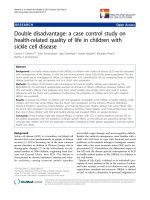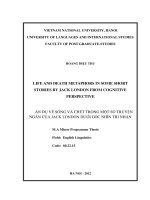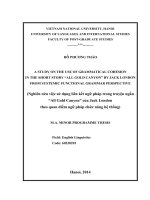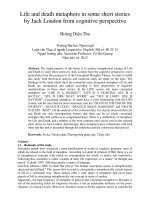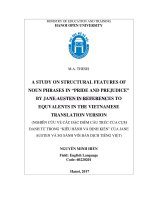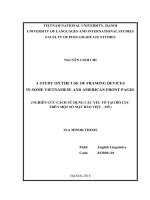Study on irony related to female characters in some short stories by w s maugham
Bạn đang xem bản rút gọn của tài liệu. Xem và tải ngay bản đầy đủ của tài liệu tại đây (812.7 KB, 53 trang )
VIETNAM NATIONAL UNIVERSITY, HANOI
UNIVERSITY OF LANGUAGES AND INTERNATIONAL STUDIES
FACULTY OF POST-GRADUATE STUDIES
NGÔ THANH HUYỀN
A STUDY ON IRONY RELATED TO FEMALE
CHARACTERS IN SOME SHORT STORIES BY
W.S. MAUGHAM
(Nghiên cứu về phép châm biếm liên quan đến nhân vật nữ trong một số
truyện ngắn của W.S.Maugham)
M.A. MINOR PROGRAMME THESIS
Field: English Linguistics
Code: 60220201
Hanoi - 2016
VIETNAM NATIONAL UNIVERSITY, HANOI
UNIVERSITY OF LANGUAGES AND INTERNATIONAL STUDIES
FACULTY OF POST-GRADUATE STUDIES
NGÔ THANH HUYỀN
A STUDY ON IRONY RELATED TO FEMALE
CHARACTERS IN SOME SHORT STORIES BY
W.S. MAUGHAM
(Nghiên cứu về phép châm biếm liên quan đến nhân vật nữ trong một số
truyện ngắn của W.S.Maugham)
M.A. MINOR PROGRAMME THESIS
Field: English Linguistics
Code: 60220201
Supervisor: Dương Thị Nụ, PhD.
Hanoi - 2016
DECLARATION
I declare that this thesis, entitled, “A Study On Irony Related To Female
Characters In Some Short Stories By W.S. Maugham” and the work presented in it
is my own and has been generated by me as the result of my own research.
I confirm that when I quoted from the work of others, the source was always
given and no part of this work has been published before submission.
Hanoi,2016
Ngô Thanh Huyề n
i
ACKNOWLEDGEMENT
During the period of completing this research, I have received great
assistance and support from many people.
First and foremost,
I would like to express my deepest thanks to my
supervisor, Ms Duong Thi Nu, who initiated me into this study and has always been
willing to give me clear and sighted guidance as well as valuable suggestions and
corrections in the completion of this research.
Secondly, I want to thank all of the lecturers, professors and doctors teaching
at the Faculty of Post-Graduate Studies of ULIS for their lessons and supports
during my MA course.
I would also like to thank my parents, my dearest friends: Nguyen Linh Chi
and Nguyen Hoang Son for their love, support and caring.
The research paper could not have been fulfilled without them.
ii
ABSTRACT
This study is carried out in an attempt to investigate ironic expressions and
their pragmatic functions in the development of female characters in some short
stories written by W.S. Maugham. However, because of the data sources and
knowledge, the writer will only focus on five short stories: “The Three Fat Women
of Antibes”, “The Escape”, “The Luncheon”, “Louise”, and “Winter Cruise”. In
order to conduct this thesis, the writer approaches irony from the stand point of
Speech Act Theory (Searle, 1969). Through identifying and analyzing ironic
expressions, it is revealed that in the selected short stories, verbal irony is the most
widely used among three types. Verbal and dramatic irony perform representative
and expressive speech acts which describe the female characters’ appearance,
personalities, dialogues, and express the narrator’s feelings and attitude towards the
female characters. Meanwhile, situational irony functions as ironic directives which
lead readers to expecting a situation which is contrary to what actually happens. In
the selected short stories, W.S. Maugham often combined two or three types of
irony. Apart from using irony as a means to mock, Maugham also employed it to
amuse and to emphasize the female characters’ special features. Some implications
in language teaching and learning English are then drawn out. Hopefully, the thesis
will serve as a useful reference for students who would like to enhance their
knowledge about British Literature, the application of Speech Act Theory into
studying irony as well as the translation of irony.
iii
TABLE OF CONTENTS
DECLARATION .................................................................................................. i
ACKNOWLEDGEMENT ................................................................................... ii
ABSTRACT .......................................................................................................... iii
TABLE OF CONTENTS ..................................................................................... iv
LIST OF TABLES AND FIGURES ................................................................... v
PART I: INTRODUCTION ................................................................................ 1
1. Rationale ............................................................................................................ 1
2. Aims of the study ............................................................................................... 2
3. Scope of the study .............................................................................................. 3
4. Significance of the study .................................................................................... 3
5. Design of the study............................................................................................. 3
PART II: DEVELOPMENT ............................................................................... 5
CHAPTER 1: REVIEW OF THEORIES AND RELATED LITERATURE 5
1.1. Theoretical Background .................................................................................. 5
a. Characterization .................................................................................................. 5
b. An overview of irony ......................................................................................... 6
c. Irony in Pragmatics ............................................................................................ 9
1.2. Related Literature ............................................................................................ 14
a. W.S.Maugham’s life and career ......................................................................... 14
b. Previous studies on irony ................................................................................... 16
CHAPTER 2: METHODOLOGY ...................................................................... 19
2.1. Research design ............................................................................................... 19
2.2. Data and data source ....................................................................................... 20
iv
2.3. Data collection procedure ............................................................................... 20
2.4. Data analysis procedure .................................................................................. 20
CHAPTER 3: DATA COLLECTION AND ANALYSIS ................................ 22
3.1. Data Collection................................................................................................ 22
3.2. Data Analysis .................................................................................................. 22
a. “The Three Fat Women of Antibes” .................................................................. 22
b. “The Escape” ...................................................................................................... 24
c. “The Luncheon” ................................................................................................. 26
d. “Louise” ............................................................................................................. 28
e. “Winter Cruise” .................................................................................................. 30
CHAPTER 4: FINDINGS AND DISCUSSION ................................................ 33
4.1. Types of irony used in the development of the female characters ................. 33
4.2. Pragmatic functions of these ironic expressions ............................................. 34
4.3. W.S. Maugham’s use of irony in the selected short stories ............................ 36
PART III: CONCLUSION .................................................................................. 38
1. Recapitulation .................................................................................................... 38
2. Limitations of the study ..................................................................................... 38
3. Implications for language teaching and learning ............................................... 39
4. Suggestions for further study ............................................................................. 39
REFERENCES .................................................................................................... 40
APPENDIX………………………………………………………………………..I
v
LIST OF TABLES AND FIGURES
Table 1 – Classification of Speech Acts (Searle, 1969) ......................................... 15
Table 2 – Number of ironic expressions in the selected short stories .................... 21
Pie chart 1: Types of irony in the selected short stories......................................... 32
vi
PART 1: INTRODUCTION
1. Rationale
The
term
“irony”
is
derived
from
the
ancient
Greek
word
εἰρωνεία (eirōneía), which means dissimulation. As a rhetorical device, irony refers
to the disagreement between the meaning intended by the author and what is
actually said.
It is believed that irony plays an important role in literature as one of the
most effective rhetorical devices. In some cases, it is even more efficient than a
direct statement since it helps create a private joke between the author and the
readers. Besides, irony is also intended to provoke the readers into critical thinking
and analyzing a situation. By comparing and contrasting what appears to be the
case, and what is actually the case, the readers can arrive at a better understanding
of the author’s intent. For example, in “Lemony Snicket: The Unauthorized
Autobiography”, Snicket writes:
“Today was a very cold and bitter day, as cold and bitter as a cup of hot
chocolate; if the cup of hot chocolate had vinegar added to it and was placed
in a refrigerator for several hours.”
As can be seen from the above sentence, Snicket makes an enjoyable ironic
statement by creating a structure that is more complex than what a reader may
usually expect.
In terms of pragmatics, irony can also be considered a subject of interest
which has been studied by many linguists such as Grice (1975), Amante (1981),
Kaufer (1981), Muecke (1982), Brown and Levinson (1987), and Hutcheon (1992).
However, irony has still remained its attraction as well as complexity as Balconi
and Amenta (2008, p.9) stated:
1
“Although frequent in our everyday conversations, irony remains a complex
communicative and pragmatic phenomenon whose correct decoding requires
specific linguistic, communicative and cognitive abilities.”
Since how irony works, positively or negatively, depends on several factors
such as people’s taste, points of view, habits, education, it seems to be really
difficult to fully understand irony in daily communication and especially literary
works.
Being inspired by the complexity of irony in literary works, the writer of this
thesis would like to investigate how ironic expressions are employed in some fiction
writings. When she approached British Literature, she was strongly impressed by
W.S. Maugham. Maugham is a famous English writer whose writings are
characterized by narrative facility, simplicity of style and an ironic point of view.
After reading a collection of Maugham’s short stories, the writer was fascinated by
the way Maugham portrayed his characters, especially female characters. They were
described not only specifically but also vividly.
All of these inspire the study: “A Study On Irony Related To Female
Characters In Some Short Stories By W.S. Maugham”
2. Aims of the study
The main aims of the research are as follows:
-
To identify different ironic expressions used in the development of female
characters in some short stories by W.S. Maugham
-
To realize the role and contribution of these ironic expressions to the
development of female characters in the selected stories.
-
To propose an insight into Maugham’s use of irony
2
In order to achieve the above aims, the study is conducted to find out the answer
to the following research questions:
1. What are the ironic expressions used in the development of female
characters in some short stories by W.S. Maugham?
2. What are the pragmatic functions of these ironic expressions?
3. What are the features of Maugham’s use of irony displayed through the
selected short stories?
3. Scope of the study
This study focuses on the ironic expressions in only some short stories
written by W.S. Maugham. The main emphasis of the study is put on identifying
these ironic expressions and their pragmatic functions to propose an insight into
Maugham’s use of irony.
4. Significance of the study
Theoretical significance: This study is expected to verifying the correctness
and significance related to pragmatictic theories of irony by working on some
fiction works
Practical significance: This thesis helps gaining an insight into the use of
ironic expressions in some short stories by W.S. Maugham.
5. Design of the study
The study consists of three main parts:
Part 1: Introduction
In this part, the writer would like to present the rationale, the aims of the study, the
research questions, the significance and the scope of the study as well as the
research methodology.
3
Part 2: Development
This is the most important part of the study which consists of the following
contents: Review of theory and related literature, Data collection and analysis, and
Findings and discussion.
Part 3: Conclusion
In the final part, the writer will briefly present the summary of the study, the
limitations, the implications in language teaching and learning as well as some
suggestions for further study.
4
PART II: DEVELOPMENT
CHAPTER 1: REVIEW OF THEORY AND RELATED LITERATURE
In this chapter, the writer presents the theoretical background related to
characterization, irony and irony in pragmatics. Basic information about W.S.
Maugham as well as previous studies on irony is also briefly reviewed.
1.1. Theoretical Background
a. Characterization
According to Harrison (1998, p.51), characterization is the concept of
creating characters for a narrative.
Writers build characters by revealing their appearance, speech, thoughts,
actions and other characters’ reactions.
Regarding appearance, writers portray characters by describing their looks,
clothes, and demeanor. For example, in “A Christmas Carol”, Charles Dickens
described Scrooge with the following lines:
“The cold within him froze his old features, nipped his pointed nose,
shriveled his cheek, stiffened his gait; made his eyes red, his thin lips blue…”
Apart from appearance, characters can be created through speech. If a story
is told by a first-person narrator, he reveals his personal trait as he tells his own
story as well as what he thinks or feels by using pronouns like I, me or we.
However, there are some cases in which some first-person narrators mislead or lie
to the audience. Besides, dialogue also reveal a lot about characters and their
relationships with each other. Therefore, when analyzing the characterization in a
story, readers should pay attention to what characters say and do not say and how
they respond to each other.
5
Concerning actions, what characters do and how they treat each other often
reveal the most about them. By observing characters’ actions, readers are able to
determine what characters’ personality is, what motivates them and how they deal
with conflict.
Additionally, writers can take readers into the characters’ minds to describe
their thoughts and feelings. As reading, readers are able to investigate whether the
characters’ thoughts and feelings match their speech and actions.
Last but not least, writers also build a character by describing how other characters
react to him/her.
In terms of types, there are two types of characterization: direct and indirect.
While direct characterization tells readers directly what characters are like or what
their motives are, indirect characterization shows readers the characters through
speech, appearance, thoughts, actions and other characters’ reactions but allow
readers to decide what characters are like.
b. An over view of irony
Definition of Irony
Until now, it seems that there is no persistent definition for the term “irony”
since it depends on the study field in which irony is researched.
The term “irony” has its root in Greek and derives from εἰρωνεία (eirōneía),
which means dissimulation. Nowadays, irony is widely used to refer to a
contradiction between appearance / expectation and reality. As a figure of speech,
irony refers to the disagreement between the meaning intended by the author and
what is actually said.
According to Thompson (1948, p.10), irony can be understood as
6
“a discrepancy or incongruity between expression and meaning, appearance
and reality, expectation and event. What we notice and then call irony is a
striking discrepancy which is artfully arranged to draw attention to itself, or
which, through occurring by chance, likewise compels our attention.”
Specifically, Muecke (1969, p. 53) defined irony as
“ways of speaking, writing, acting, behaving, painting, etc., in which the real
or intended meaning presented or evoked intentionally quite other than, and
incompatible with, the ostensible or pretended meaning.”
Besides, briefly, Galperin (1971, p.142) claimed that irony was a rhetorical
device which based on recognition of the logic – dictionary meaning and contextual
meaning while these two coexisting meanings were opposite.
From these views, it can be concluded that irony means far more than just
“saying one thing meaning another”. The term is used to refer to the way of using
words to express something different from and often opposite to their literal
meaning. In short, an expression or utterance is considered as an ironic one when it
is characterized by a contrast between apparent and intended meanings.
Types of irony
There are two classifications of irony; while the first one is based on what
the ironist expects from his semantic displacement, the second one takes modern
theories of rhetoric as its basis.
- Classification based on semantic displacement
First and foremost, irony can be classified on the basis of what the ironist
expects from his semantic displacement. These are classic irony, romantic irony,
and critical irony. (Erdogan, 2010)
7
Classic irony is usually employed in the course of a dialogue in which the
speaker intends to contrast his reasoning to the interlocutor’s, thereby pointing to a
disparity between the two. However, the disparity is intended to resolve
immediately on the speaker’s side, giving way to further dialogue to make the
interlocutor follow the speaker’s reasoning.
Romantic irony, on the other hand, is distinguished by the spirit of
romanticism: a conception of “universe founded in chaos and incomprehensibility
rather than in a divinely or drained teleology” (Mellor, 1980, as cited in Erdogan,
2010). A romantic ironist employs irony to constantly undermine given meanings,
with the hope that this undoing will eventually result in a state of privilege and
security he has been longing for (Lang 1996, p.576).
The third type of irony, in terms of the ironist’s intention, is critical irony.
Critical irony still wants to displace the meaning in traditional and grand narratives,
but it differs from the romantic irony in that it does not hope and aim for a greater
narrative.
- Classification based on modern theories of rhetoric
Within the scope of this study, the writer would like to employ the
classification based on the modern theories of rhetoric. In terms of rhetoric, irony
can be classified into three types: verbal irony, dramatic irony and situational irony.
(Cuddon, 1998, p.427-432; Colebrook, 2004, p.13)
Verbal irony is a statement in which the meaning intended by a speaker is
sharply different from the meaning that is ostensibly expressed. In other words,
verbal irony refers to the contradiction between what is intended and what is
actually said. For example, the Prologue in Act I of “Romeo and Juliet” opens with
“Two households, both alike in dignity,…” however, as the play goes on, the
8
readers then realize that both of the families are violently competitive, thus,
undignified.
Another type of irony is dramatic irony which refers to the difference
between what the characters believe to be true and the facts that the reader knows.
More specifically, it denotes the fact that the readers know beforehand more about
the situation, truth or end than the character himself. For example, in “Romeo and
Juliet”, the readers know that Juliet took a sleeping potion and isn’t really dead.
However, Romeo doesn’t know about this fact. Having great sorrow and unceasing
anguish, he then commits a suicide.
The most common type of irony used in fiction is situational irony. It is
regarded as the discrepancy between what is expected in a certain situation and
what actually happens. This type of irony often arises from the circumstances and
events of a story. For instance, the readers usually expect a happy ending for young
lovers. In fact, in “Romeo and Juliet”, the couple finally spends eternity together,
but not in the way that the readers had hoped.
Among these three types, dramatic irony and situational irony usually appear
through the macro structure of the fiction; therefore, it requires the reader’s
perceptivity to recognize these two types of irony as well as their dramatic effects.
Meanwhile, verbal irony often appears through the micro structure - the interchange
and conversation among characters, or it is expressed through the way the author
describes the characters.
c. Irony in pragmatics
In terms of pragmatics, it seems that irony has been a subject of interest
because a number of approaches to this issue have been proposed since 1975. The
9
study of irony in pragmatic begins with the work of Grice, then moves onwards to
Relevance Theory Indirect Negation Theory, Speech Act Theory, and so on.
The Cooperative Principle (Grice, 1975)
The cooperative principle includes four maxims of quality, quantity, relation
and manner which should not be flouted in order to avoid ambiguity. However, the
flouting of these maxims allows the speaker to use different figures of speech and
enrich the conversation, be more polite or less aggressive than the speaker
would be if he followed the rules based on the four maxims. If the cooperative
principle is fully observed, there is no difference between the sentence and the
speaker meaning.
Grice later proposed a theory of irony, in which he argued that using irony
means flouting at least one of the maxims of the cooperative principle. However, it
is not possible to go by this principle in every situation. As Barbe (1995, p.54)
points out, there are situations when irony is “expected and acceptable”. For
instance, in the performance of a stand-up comedian, irony is expected by the
audience so it is questionable if irony is in fact flouting for example the maxim of
relation. Barbe (1995) further claimed that not every conversation can be led by the
cooperative principle.
The Relevance Theory (Sperper & Wilson, 1975)
Later, Sperper and Wilson criticized Grice’s theory of irony, and argued that
irony is not always present if at least one of the maxims is flouted. They proposed
the relevance theory, assuming that every utterance fulfilling or flouting Grice’s
maxims was formulated in that way for a reason. Therefore, they are relevant, and it
is the interpreter’s job to decode the speaker meaning based on the sentence
meaning, the context and on the seemingly irrelevant information that the speaker
gives.
10
The Indirect Negation Theory (Giora, 1998)
Giora agreed with Grice in dividing the interpretation of an utterance into
two sections, first understanding the literal meaning, secondly the underlying
message.
Giora’s indirect negation theory argues that the negation in irony cannot be
direct, so grammatical, and only indirect. She then proposed that irony is a form of
indirect negation, which means the ironist negates without using an overt negation
marker (Giora, 1998, p. 4). She further argued that direct negation cannot be used in
interpreting literal irony. If a literal ironic utterance is grammatically negated, its
meaning will not reflect the underlying ironic meaning. For example if the utterance
“This meat is black” is directly negated, it becomes “This meat is not black” which
does not correspond with the underlying meaning, “This meat is uneatable”.
Speech Act Theory
- Feasibility of applying Speech Act Theory to verbal irony
Several researchers such as Van Dijk (1976), Leech & Short (2001), and
Zhang (2013) have approached irony from the standpoint of speech act theory.
To begin with, Van Dijk (1976) suggested that “ literature” itself be regarded
as pretended speech act with its own felicity conditions. Therefore, fiction can be
considered a one-sided conversation between the author and the reader in which the
author not only informs the reader “about a particular fictional world, but also needs
to achieve a rapport with his readers, an identity of view point where by the
contents of the fiction will be interpreted and evaluated in an appropriate way”
(Leech & Short, 2001, p.257).
Based on Van Dijk (1976)’s and Leech & Short (2001)’s opinions, Zhang
(2013) claimed that irony, as a technique of expressing the author’s or characters’
11
attitudes, used by the author in his communication with the reader can be a type of
pretended speech act with indirectness and intention as its characteristics and
insincerity as a felicity condition. Concerning indirectness, irony is a figure of
speech expressing purposes in a roundabout way. When irony occurs, there is
apparently a mismatch or even a contrast between the intended meaning and the
literal meaning. Hence, it can be inferred that indirectness is a characteristic of
irony. The second point is that when uttering an irony, a speaker can adjust the level
of emphasis of the ironic comment to affect the interlocutor. Therefore, intention is
another feature of irony. With regard to insincerity, based on Searle’s set of felicity
conditions, Zhang (2013) argued that sincerity forms a necessary condition in
producing any speech act, and it requires that the utterances the speaker produces be
in absolute consistent with the speaker’s intentions. On the contrary, insincerity acts
as a felicity condition in the case of irony because the proposition expressed via
irony is usually opposite to the meaning intended by the speaker. Moreover, in Van
Dijk’s (1976, as cited in Zhang, 2013) point of view, a successful irony depends
mainly on the condition of insincerity.
Inspired by the feasibility of applying Speech Act Theory in studying irony,
the writer of this thesis would like to approach ironic expressions in some of
Maugham’s short stories from this point of view.
- An overview of speech act
The concept of “speech act” was proposed by Austin in 1962, and later
developed by Searle in 1969.
More than half a century ago, Austin gave a series of lectures at Harvard,
which were published posthumously as a book entitled “How to Do Things with
Words”. In this book, Austin presented a new picture of analyzing meaning.
Meaning is described in a relation among linguistic conventions correlated with
12
words/sentences, the situation where the speaker actually says something to the
hearer, and associated intentions of the speaker. The idea that meaning exists among
these relations is depicted successfully by the concept of acts: in uttering a sentence,
the speaker with an associated intention performs a linguistic act (a speech act) to
the hearer. Speech acts, therefore, can be briefly defined as actions performed via
utterances.
According to Austin (1962), on any occasion, the action performed by producing
an utterance will consist of three related acts.
1. Locutionary act refers to the act of producing a meaningful utterance.
2. Illocutionary act can be understood as the intention of the speaker.
3. Perlocutionary act refers to the effect of the utterance on the hearer.
Austin (1962) then classified illocutionary acts into five types, i.e., verdictives,
exercitives, commissives, behabitives, and expositives. However, it is often argued
that Austin’s classification is not complete and those coined categories are not
mutually exclusive.
In 1969, Searle inherited his ideas from Austin and elaborated on some of them.
Searle, then, developed the theory in his own fashion: the essence of it being that to
perform an illocutionary act is to express an illocutionary intention.
He also proposed a different classification of speech acts as follows:
Declarations
Representatives
Speech acts that change the world via their utterance
Speech acts which describe states or events in the word, such as
an assertion, a claim, a report
Speech acts in which the speaker expresses feelings and
Expressives
attitudes about something, such as an apology, a complaint, to
thank someone, to congratulate someone
13
Directives
Commissives
Speech acts that have the function of getting the listener to do
something, such as a suggestion, a request, or a command.
Speech act that commit the speaker to doing something in the
future, such as a promise, or a threat.
Table 1 – Classification of Speech Acts (Searle, 1969)
1.2. Related Literature
a. W.S. Maugham’s life and career
W.S. Maugham was born on the 25th of January, 1874 in Paris. His father,
Robert Ormond Maugham, was a lawyer who handled the legal affairs of the British
Embassy in Paris. Maugham’s mother, Edith Mary, had tuberculosis, for which her
doctor prescribed childbirth. Several years after the last of his three older brothers,
she gave birth to Maugham.
Unfortunately, Maugham’s childhood was awful for him. After the death of
his mother when he was eight and that of his father when he was ten, Maugham was
under the care of his uncle, Henry MacDonald Maugham, the Vicar of Whitstable,
in Kent. Then, Maugham was sent back to England for schooling. He attended The
King's School in Canterbury, which was difficult for him as he was teased for his
bad English and his short stature. Suffered from both at his uncle's vicarage and at
school, Maugham developed an ability of making wounding remarks to those who
displeased him, which is sometimes reflected in Maugham's literary characters.
At the age of sixteen, he refused to continue at The King's School, and then
went to Germany and studied medicine at the University of Heidleberg. After
having returned to England, he worked at Saint Thomas’s hospital. Though
Maugham was a qualified doctor, he devoted his life to literature. In fact, there have
been several criticisms that the years Maugham spent studying medicine were a
14
creative dead end. However, Maugham felt that the experience as a medical student
was truly valuable for his writing career.
Although Maugham's first and many other relationships were with men, he
also had been linked to a number of women. In May 1917, he married Syrie
Wellcome. However, Syrie finally divorced Maugham in 1929 as she found his
relationship and travels with Gerald Haxton too difficult to live with.
In his sixties, Maugham spent most of his time in the US, first
in Hollywood and later in the South. After his companion Haxton died in 1944,
Maugham returned to England. In 1946 he moved to his villa in France, where he
lived until his death in 1965.
W.S. Maugham first tried his hand at novels and then plays and short stories.
His rich experience of life and his acute insight into human nature laid the
foundation for the analytical and critical quality of his works. He wrote 19 novels,
24 plays, and a large number of short stories. Some of his most famous short story
collections are: Ashenden (1928), Cosmopolitans(1936) and Quartet (1948).
W.S. Maugham is well-known for his unique writing style characterized by
exotic situations, engaging characters, riveting plots and ironic tone.
In his writings, the characters are portrayed in exotic situations. For instance,
in “The moon and sixpence”, Charles is a middle-aged English stockbroker, who
abandons his wife and children abruptly to pursue his desire to become an artist.
Meanwhile, it is a common belief that when a man abandons his family, it is likely
because he has a love affair.
15
Another factor that contributes to Maugham’s writing style is engaging
characters. The characters are described vividly with their specific characteristics.
Additionally, like other realist, Maugham pays special attention to make his
characters not only lively but also real. As a result, the readers may feel that they
have met that character in everyday life. For example, in „The Escape”, Roger
appears as a middle – aged wealthy man who is cautious, gallant and experienced.
However, he still goes down “like a row of ninepins” because of a woman
It is believed that Maugham is the master of riveting plots. In his writings,
the main characters appear in conflicts with themselves or with other characters.
Hence, it makes the readers want to see how the main characters solve the problem.
For instance, in “The Luncheon”, the narrator struggles with financial problem
when he has a luncheon with the woman. It is not certain that he has enough money
for the bill or not, and each time that the woman orders an expensive dish, the
readers become more curious about the end of the story.
Maugham is also famous for his ironic tone. In his writings, the irony can be
easily found in the way he describes the characters. For example, in “The
Luncheon”, the woman is described with these sentences: “She was not so young as
I expected and in appearance imposing rather than attractive. She was, in fact, a
woman of forty ( a charming age, but not one that excites a sudden and devastating
passion at first sight), and she gave me the impression of having more teeth, white
and large and even, than were necessary for any practical purpose.”
b. Previous studies of irony
Regarding irony, a number of studies have been conducted from the
perspective of literature, sociology as well as linguistics in general and pragmatics
in particular.
16
Cook (2005) conducted a research named “A Pragmatic Analysis of Irony”
to examine a process of understanding irony in relevance theory. The results of the
study have shown that the notion of echoic interpretive representation suggested in
the relevance-theoretic framework provides an explanatory account of various
ironic utterances which involve disapproval, reject, ridicule, or discontent besides
opposite meaning. In addition, the interpretation of ironic utterances, like other
utterances, is achieved by searching for the relevant assumptions consistent with the
principle of relevance.
Palinkas (2013), on the other hand, implemented a study on the topic of irony
and the Standard Pragmatic Model (Grice, 1975, 1978). While the Standard
Pragmatic Model assumes that an ironist means the opposite of what he says,
Palinkas claimed that the opposite meaning of an ironic utterance can occasionally
be interpreted in relation to both the predicate and the propositional negations of
what an ironic speaker actually says. Hence, he insisted that earlier attempts at
examining irony from the standpoint of predicate and propositional negation should
be revised.
Interestingly, Hirsch (2011) carried out a research to distinguish between
irony and humor in the context of literary texts. She proposed a comparative
pragmatic model based on existing models of Clark and Gerrig (1984), Grice (1975,
1978), Haverkate (1990), Sperber and Wilson (1981), Wilson and Sperber (1992),
Alexander (1997), Jeffers (1995), Oring (1989), Raskin and Attardo (1994). The
research was based on four conceptual paradigms: pragmatic studies of irony,
pragmatic studies of humor, a pragmatic approach to the study of literary texts, and
theories of text interpretation.
Concerning irony in fiction works, Huang (2011) conducted a pragmatic
study on irony in Samuel Beckett’s plays. The author applied post-Gricean theories
17
